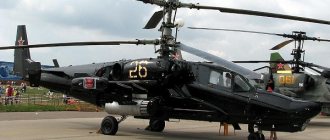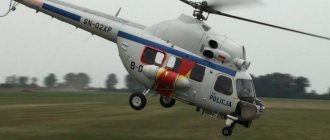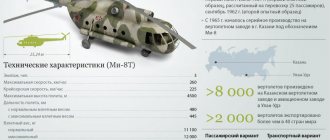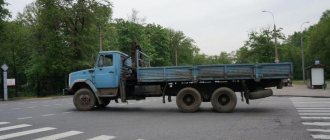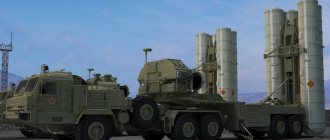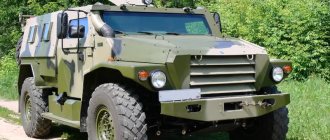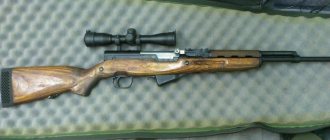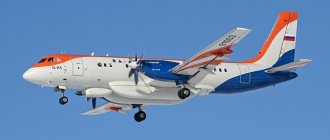The intensive development of agriculture and industry in the 50s of the last century gave a powerful impetus to the development of civil helicopter construction. A prominent representative of such machines was the Ka-26 multi-purpose helicopter. Despite its purely civilian purpose, the equipment received the NATO designation Hoodlum (Hooligan).
The helicopter was produced for about 20 years and was supplied not only to socialist, but also to capitalist countries. Ka-26 vehicles were found in Germany, Sweden, Japan and even the USA, where they got there the hard way through a system of front companies.
History of creation
The beginning of the 60s was memorable for the workers of the N.I. Design Bureau. Kamov received a task from the government to develop a helicopter for the national economy capable of working with various types of removable equipment. It was decided to put Deputy Chief Designer M.A. at the head of the project. Kupfer.
In the first month of spring 1965, a prototype of the machine was built and already in May of the same year, test pilot V.I. Gromov lifted the helicopter off the ground and checked the operation of the engines in hover mode. It just so happened that on aviation day, August 18, 1965, the Ka-26 made a test flight in a circle.
Ka-26
Then there were more flights in a circle and into the zone, checking all modes - in general, the usual work on fine-tuning the helicopter, and in 1966 state tests began. The machine turned out to be surprisingly successful, especially the speed with which it was possible to convert the helicopter for any purpose was noted.
The original design of the machine - a “flying chassis” - allowed a team of three people to mount any version within 1.5-2 hours: passenger, cargo and agricultural. In fact, for this unique design, the helicopter received a gold medal at an international exhibition.
In 1967, the aircraft was shown in France at an air show, then after testing, for the first time in the domestic helicopter industry, an international certificate of airworthiness was received according to US standards.
In 1969, factories located in Buryatia began serial production of helicopters.
Ka-26 "Hooligan"
Universal Ka-26
Work on the design of the Ka-26 multi-purpose civilian helicopter began at the end of 1962 and for a long time was carried out on an initiative basis by a small group of specialists from the Kamov Design Bureau. By this time, the country had accumulated extensive experience in using the Mi-1, Mi-4, Ka-15 and Ka-18 in the national economy. The OKB team had a wealth of material to analyze the advantages and disadvantages of these machines, the results of which strengthened N.I.’s confidence. Kamov in the prospects of working on further expansion of the family of coaxial helicopters.
The civilian versions of the Mi-1, Mi-4 and Ka-15 were created as modifications of military vehicles, so they had low economic characteristics. Agricultural Ka-15s, although they provided the necessary agrotechnical effect due to such advantages of the coaxial design as ease of control, good maneuverability combined with small dimensions and symmetry of the air flow from the rotors, had insufficient carrying capacity, which negatively affected their economic performance. In addition, these machines were used practically only for a few months a year, since it was ineffective to use them for other purposes.
Ka-15.
During the fine-tuning of the Ka-15, a significant part of which was carried out after the cessation of their serial production, the Kamov Design Bureau established close contacts not only with the flight and technical personnel of the helicopter units, but also with the managers of the farms operating these helicopters. This allowed designers to better understand the specifics of using rotorcraft and more clearly formulate the requirements for them.
The State Research Institute of Civil Aviation conducted studies that showed that a helicopter for the national economy in an agricultural version should lift up to 600-700 kg of pesticides and allow use in other versions. The flight range of a helicopter in a transport version with a full commercial load must be at least 400 km. These provisions formed the basis of the tactical and technical requirements of the MGA issued for the development of the vehicle.
When designing the Ka-26, materials from a project with a similar designation, completed by OKB employees in the early 1950s under the leadership of Deputy Chief Designer V.V., were used. Nikitina. The project had the external placement of two AI-14V piston engines with their toes facing one another. However, due to the insufficient power of the AI-14V (255 hp) and high weight, satisfactory flight characteristics were not guaranteed, and the project was rejected.
By the beginning of the 1960s, at OKB I.M. Vedeneev developed a helicopter engine AI-14VR with a power of 325 hp. Tested on the Ka-15, this engine made it possible to dramatically improve the aircraft's flight characteristics. However, various factors prevented the introduction of the AI-14VR on the Ka-15 and Ka-18, but the opportunity arose to use it on the Ka-26, since it had a number of advantages over the GTD-350 gas turbine engine of equal power.
In January 1964, the Council of Ministers issued a resolution on the creation of the multi-purpose Ka-26 in agricultural (carrying capacity 600-700 kg of pesticides) and transport (for 6 passengers with a range of 400 km) versions. After this, work on the multi-purpose helicopter developed on a broad front and was successfully completed in a short time.
At the end of May 1965, the Ka-26 took off from the ground for the first time, and on August 18 it made its first circling flight. Flight testing and development were carried out simultaneously on three machines, which increased the quality of testing and significantly reduced their time. In 1967, the second stage of state tests was successfully completed, and the Ka-26 was launched into mass production. From 1967 to 1972, they created ship, ambulance and geological exploration versions of the vehicle for patrolling forests and highways (for traffic police), as well as a helicopter crane.
When building a multi-purpose machine with high profitability, in addition to meeting general requirements such as low price, long service life, ease of operation, etc., which determine the cost of a flight hour, it was necessary to ensure the greatest weight return in each of its options. In solving this problem, the designer inevitably faces a contradiction, which consists in the fact that when adapting a helicopter with a conventional layout for another application, there will inevitably be some “extra” structural elements and equipment on board, but they will make it heavier, which reduces the weight return.
Therefore, for the Ka-26 they decided to use the “flying landing gear” scheme, in which the helicopter consists of a “carrier” of an unchanged configuration in all variants and a set of easily removable attachments, including a cargo-passenger cabin, a cargo platform, a set of agricultural equipment and devices for transporting goods on external suspension. This allows a helicopter to be transformed from one option to another in 1.5-2 hours by a team of three people. Thus, thanks to the original layout, it was possible to create a multi-purpose machine with high weight output in each of its variants.
In particular, in the agricultural version, the Ka-26 was far superior to the previously produced Mi-1 and Ka-15 in terms of load capacity per unit of power. Naturally, this arrangement worsened the external aerodynamics of the helicopter and negatively affected its speed, but for a machine of this type it is not a determining parameter, and the flight performance characteristics of the Ka-26 in the transport version were quite satisfactory due to the low specific costs of the piston engines. Despite the absence of a fuselage, the power circuit of the vehicle is designed in such a way that the main loads from the main rotor, landing gear, tail and attachments are closed along short paths on a fairly light and rigid central power compartment.
“Ground resonance,” as well as flutter and dangerous convergence of blades, are among the “childhood diseases” of coaxial helicopters. The task was complicated by the fact that the high height of the landing gear, due to the layout of the vehicle, practically did not allow them to be sufficiently rigid, as required. To ensure the required margin for “ground resonance”, an original solution was found, according to which the rigidity of the main struts should not be increased, but sharply reduced by introducing an additional degree of freedom in the transverse direction. As a link that determines the lateral rigidity of the strut, a special lateral movement damper with rubber shock absorbers was used, the rigidity of which could be changed during development.
Subsequent tests confirmed the correctness of this approach. As a result, the Ka-26 acquired a sufficient margin of “ground resonance”, which later even made it possible to remove the corresponding dampers from the lower rotor hub. During the period of operation of the machines, not a single case of the occurrence of “ground resonance” was noted. It should be noted that this landing gear design, while distinguished by its undeniable advantages, also brought a significant disadvantage to the helicopter, namely: the additional degree of freedom of the main struts increases the roll of the machine when landing on an inclined surface, which limits the capabilities of the machine when operating on ships due to pitching.
The issues of blade convergence were carefully and in detail studied at the Design Bureau when fine-tuning the Ka-15 and Ka-25. Works of RA. Mikheeva (LII) and L.A. Potashnik made it possible to quite correctly determine the main rotor control parameters. By the beginning of flight tests, in order to ensure the required distance between the tips of the upper and lower rotor blades, experimental column parts were made, which, if necessary, made it possible to change the characteristics of the flapping regulator and the value of the advance angle in the main rotor control system.
Based on the results of the first flights near the ground, the required adjustment was carried out, on the basis of which the corresponding parts were manufactured in the final design. During the tests, the efficiency of the directional control was also slightly reduced, which further increased the reserve for “blade convergence.”
During the operation of helicopters, it became necessary to install centrifugal blade overhang limiters on the upper rotor hub to increase the distance between the tips of the blades when spinning and stopping the rotors, which was done. Subsequent flight tests with measurements of the distance between the tips of the blades in flight showed that there was sufficient margin for their approach in all operating modes. Despite this, during mass operation of the Ka-26, there were several episodes of blade collisions at low speeds when the rotors were spinning and stopping.
To eliminate this phenomenon, special tests were carried out, which showed that even a slight deviation of the swashplate from a position perpendicular to the rotor shaft causes, in moderate wind, a sharp increase in the flapping motion of the blades at low speeds, as a result of which, with an unfavorable combination of certain factors, their collision may occur.
The test results made it possible to include appropriate recommendations for the pilot in the technical documentation, after which incidents of blade collisions did not recur. The results of the work carried out on the Ka-26 to ensure the required margin for the convergence of the blades confirm that the task of creating a coaxial helicopter, which completely eliminates the crossing of the rotor blades in all operating modes, has been finally solved.
The Ka-26, in its main parameters, was in the middle between the previously mastered and well-studied Ka-15 and Ka-25. The creators of the Ka-26 had the opportunity not only to implement the experience gained during the design and development of these machines, but also to implement a number of original design solutions that made it possible to obtain additional qualities on the new helicopter.
The Ka-26 has outstanding performance in terms of efficiency-cost criteria. It is significantly superior to the Mi-2 in terms of carrying out aeronautical chemical work and transporting large cargo on an external sling. The Kamov helicopter, with lower engine power and lower dead weight, carries the same load as the Mi-2 in the cargo compartment and 200 kg more - using an external sling. The Ka-26 has twice the range with full internal tanks than the Mi-2.
The new Kamov helicopter became especially attractive for operators thanks to its main rotor blades (ROB) made of fiberglass. They had a service life of more than 5,000 flight hours, which was 10 times greater than the service life of the metal Mi-2 blades. The design and manufacturing technology of these blades have been patented in five leading helicopter manufacturing countries. This circumstance and the patent purity of the coaxial design helicopter allowed the Ka-26, the only Soviet rotary-wing aircraft, to receive a certificate according to American airworthiness standards. During the certification process, flight and special tests of the vehicle were carried out, and changes were made to the design. As a result, they also received type certificates in Poland, Sweden and Germany. For many years, the Ka-26 was successfully demonstrated at many international exhibitions and flew in a number of countries in Europe, the Middle East and America.
Until the 70s of the last century, several different modifications of the helicopter were produced: ship, forest patrol, ambulance, geological exploration, flying crane, patrol for traffic police and others. Over the years of serial production, more than 860 Ka-26s were built. This helicopter was operated in 17 foreign countries. The Ka-26, as a rule, was used for civilian purposes, but it was also adopted by the Romanian and Hungarian air forces, as well as the police of the GDR and the Federal Republic of Germany. The helicopter set 5 world aviation records, including: an altitude record for helicopters with a take-off weight of up to 3000 kg - 5330 m, and a climb rate record - climbing to a height of 3000 m in 8 minutes and 51.2 seconds.
An analysis of the results of operating the Ka-26 in our country and abroad shows that the machine fits well into the range of helicopters currently in service, the possibilities for its use are far from being exhausted, and it can be very durable if it is improved in the process of creating new modifications. A further development of the design was the Ka-126 helicopter, equipped with a gas turbine engine, and the Ka-226 helicopter with a power plant of two gas turbine engines.
Sources: Lebed V. Helicopters of the world. M.: JSC “Editorial Board of the Magazine “Boomerang”, “April”, 1994. P.114-115. Babin E. In the cockpit of the “dragonfly” // Aviation and time. 2014. No. 4. pp. 32-33. Grigory Kuznetsov G. Kamov flying chassis // Wings of the Motherland. 2000. No. 5. pp. 8-10. Kupfer M. For the national economy // Wings of the Motherland. 2002. No. 11. pp. 3-5. Petrov B. Universal helicopter // Model designer. 1966. No. 7. pp. 25-27.
Design Features
The helicopter is built according to the aerodynamic layout characteristic of all Kamov machines - a coaxial design with two main rotors, a power plant with two piston engines and a fuselage in the form of a platform.
The supporting system is represented by two three-blade propellers made of a new material for aircraft manufacturers - fiberglass.
Two M-14V26 piston engines are mounted on the sides of the platform in engine nacelles.
The cockpit has two seats, one of them is passenger. The pilot's visibility is good thanks to the large glass area. To work with chemicals, a filter element is installed that purifies the cabin air and a separator-supercharger.
Ka-26
In the transport version, a passenger module with folding seats and an entrance door in the rear is installed on the platform behind the pilot's compartment. It is equipped with a ventilation and heating system; inside the passenger module there is a hatch embedded in the floor for boarding and disembarking people in hover mode.
In the version for the transportation of large cargo, a cargo platform is installed, on which folding sides are provided for quick loading.
A fuel supply of 620 liters is located in three tanks (two in the front and one in the rear); for longer flights, two additional tanks of 160 liters each can be installed on both sides of the passenger module.
The helicopter has four landing gear, two rear landing gear are equipped with brakes and nitrogen-oil shock absorbers with dampers to dampen lateral vibrations. The front struts have a self-orientation system, the landing gear is non-retractable.
It must be said that this design of a helicopter with a platform is far from aerodynamic perfection and affects the maximum speed, but a working helicopter does not need it; almost all work is performed at low speeds near the ground. But in such operating modes, all the advantages of the aerodynamically symmetrical coaxial design of this machine are used to the maximum.
Ka-26 sprays with toxic chemicals
Flight performance
- Fuselage length - 7.75 m
- Fuselage width - 3.64 m
- Height with rotating propellers - 4.05 m
- Screw diameter - 13 m
- Unloaded helicopter weight - 2072 kg
- Maximum take-off weight - 3250 kg
- Engines - 2 x M-14V26
- Power - 2 x 325 hp.
- Number of passengers - 7 people
- Maximum speed - 160 km/h
- Cruising speed - 130 km/h
- Range - 520 km
- Range: 465 km
- Practical ceiling - 3000 m
- Crew - 1 person.
Cockpit of the Ka-26
xDE YANGDIUMKH "KERYUCHYETSN YUYAYAKH" BOEPBSHE ASHKYU PEYUKHGNBYUMYU B NYA YYULNBU B LYUE 1965-CN, YNTSDU YANYARNKYAK OEPBSHI ONDZEL B BNGDSU LMNTSNZHEKEBNTSN BEPRNAKER YU LNDSKEMNI YNMYARPSYZHHH yU-26. oHKNRKHPNBUK ETSN GYUBNDYAYNI KERVKHY-HYAOSHRYUREKE b.tsPNLNB.VRN FE GYUYARYUBKHKN YNMYARPSYRNPNB nya yYULNBU NAPIURKHREYY OPNEIRKHPNBYUMKHCH RUYNTSN, OPILN YAYUFEL, MENASHVMNTSN KERYUREKEMNTSN YOOYUPYURYU? DEKN B RNL, VRN I 1956-CN B yayaap MYUVYUKNYAE bHPNYNE HYAONKEGNBYUMHE BEPRNKERNB lH-1 X yu-15 MU YUBKHYUZHNMMN-UHLHVEYAYHU PUANRYUU: BMEYAEMHE SDNAPEMKHI B ONVBS ONKEY, YU DNB X BKHMNTsPYUDMKHYNB; ANPEAYU I BPEDMSHLH MUYAYAINLSHLH X YANPMYYULH. NOSHR KH OPHLEMEMKH NYUGYUKYA MUYARNKEIN SDYUVMSHL, VRN BYAINPE Y MHL OPKHYANEDKHMKHKYA ANKEE TsPSGNONDZELMSHI lH-2.
tPNMR YAEKEYAYUNUNGYARBEMMSHU YUBKHYUZHNMMSHU PYUANR MEOPEPSHBMN PUYAHPKYA. ETsN B ONKMNI LEPE SFE ME LNTSKKH NAEYAOEVHRE MH YuM-2, MH lH-2, BOEPBSHE YANBEPHBKHI ONKER B YAEMRYAPE 1967-TsN. YARYUKN NVEBKHDMSHL, VRN RPEASERYA YAOEZHHYUKHGHPNBUMMSHI H ANKEE TsPSGNONDZELMSHI KERYUREKEMSHI YOOYUPYUR DK BKHPNYNTSN YNLOKEYAYU YUBHYUZHNMMSHU PYUANR. HLEMMN RUYNI LYUHMNI H YARYUK yu-26
.
ECN ONYARPNIYU B 1964-L ASHKYU GYUDYUYU ONYARYUMNBKEMHEL OPYUBHREKEYARBU, OPHVEL TSEMEPYUKEMSHL GYUYUGVKHYNL BSHYARSOYUK cbt. schRN ASHK EDHMYARBEMMSHY BEPRNKER B YARPUME, YNRNPSHY HYAONKEGNBUKYA KHYAKCHVHREKEMN B LHPMSHU ZHEKYU. mYuD MHL ME DNBKEKH RPYUDKHZHNMMN FEYARYKHE RPEANBYUMKH bbya, VRN ONGBNKKKN nya OPNJBKHRE LYYYAHLSL RBNPVEYAYNI KHMKHZHYURKHBSH.
xGBEYARMN, VRN NDMNI HG OPNAKEL OPNEIRKHPNBUMHYUOOYUPYURYU LMNTsNZHEKEBNTSN MYUGMYUVEMHYABKERYA NAEYAOEVEMHE LYYYAHLYUKEMNI BEYANBNI NRDYUVH B YUFDNL YNMYPER MNL BYUPKHUMRE OPHLEMEMH. SCHRYU YUYUPYYREPHYARKHYU B JANVERYUMHH I BSHYANNI RNOXBMNI SHTTEIRKHBMNYARECH, ANKEHL PEYASPYANL YUTSPETSYURNB, SGKNB X YAKHYAREL, OPNYARRNNI SHYAOXYURYUZHHH, NRMNYAHREKEMN MHG YNI YARNHLNYARH LYUHM, B YNMEVMNL YAVERE, KH NOPEDEKCHR YARNHLNYARE KERMNTSN VYUYU. ONSHRNLS YAOEZHKHYUKHYARSH YYULNBYAYNI YNMYARPSYRNPYAYNI YNKSH OPKHMKKH PEEMKHE YAOPNNEIRKHPNBURE OKYUMEP BEPRNKERYU ON RHOS "KERYUCHYETSN YUYAYAKH", YNRNPSHI ASDER MEHGLEMMNI VYUYARE H BYAEU BYUPKHYUMRNB, X NYAMYUYURE ETSN YNLOKEYRYULH ASHIARPNYAZELMNTSN YAOEZHYUKEMNTSN NANPSDNBYUMKH.
GUAYETSYU BOEPED, NRLERKHL, VRN JU-26 YANNYAMNI YAUELSH I DBSL ONPMEBSHLH DBKHTSYUREKLH X VERSHPEUYARNEVMSHL yuYAYAH NYUGYUKYA DUKEY NR YUSCHPNDKHMYULKHVEYYNTSN YANBEPEMYAR BYU. schRN NRPKHZHYUREKEMN YAYUGYUKNYAE MU BEKKHVKHME LYYYAHLYUKEMNI YAYNPNYARKH, ME ЪБКЪЧИИИЪ, OPYUBDU, NOPEDECHYEI DK BEPRNKERYU-RPSFEMHYU, YNRNPSHI ANKENNI NAZEL PUANR BSHONK MYER BAKHGH GELKH MU LYUKSHU YAYNPNYARU. b RN FE BPEL MU DUMMSHU PEFKHLYU ONKERYU BAKKHGH OPETSPUD MYUKHKSVHL NAPYUGNL HYAONKEGSCHRYA DAYRNHMYARBU YANNYAMNI YAUELSH: YNLOYUYRMNYARE, UNPNNYU LYUMEBPEMMNYARE, BSYA NYU RЪTSNBNNPSFEMMNYARE H, MUYNMEZH, OPNYAREIYU REUMKHYU OKHKNRHPNBYUMH YUSCHPNDHMYULHVEYAYKH YAHLLERPHVMNI BKHMRNYPSHKNI LYUHMSH.
ON YPHREPHCH "SHTTTEIRKHBMNYARE-YARNHLNYARE" yu-26 ЪБКЪРІАЪ BSHDUCHYKHLYA BEPRNKERNL. nM YASYYYARBEMMN OPEBGNYEK lH-2 B NAKYUARKH BSHONKMEMHYUBHYUZHNMMN-UHLHVEYAYHU PYUANR X RPYUMYAONPRHPNBYKH YPSOMNTSYUAYUPHRMSHU TsPSGNB MU BMEMEI ONDBEYAYE.
yu-26 OPH LEMEKHU LNYNYARKH DBKHTSUREKEY KH YANAYARBEMMNI LYUYAYASH OEPEBNGHR NDKHMYYINBSHI I lH-2 TsPSG B RPYUMYAONPRMNI YUAHME KH MU 200 YTS ANKEYE - MU BMEMEI ONDBEYAYE. nM HLEER ONVRKH B DBYU PYUGU ANKESCH DUKEMNYARE I GYUOPYUBYNI BMSRPEMMKHU AYUNB, VEL lH-2.
nyanaemmn OPKHBKEYUREKEMSHL DK ShYYAOXYURYUMRNB yU-26 NYUGYUKYA, AKYUTSNDYUP YAREIKNOKYYARKHYNBSHL KNOYUYAROL MEYASYETSN BKHMRYU (mb) I PEYASPIANL ANKEE 5000 KERMSHU VYUYA NB, ONVRKH B 10 PYUG OPEBNYAUNDKHBKHI PEYASPYA LERYUKKKHVEYAYKHU KNOYUYAREI lH-2. yNMYARPSYZHKH KH REUMNKNTSKH KHCTSNRNBKEMKH SCHRKHU KNOYUYAREI ASHKKH GYUOYUREMRNBYUMSH B ORKH BEDSYKHU GYUPSAEFMSH YARPYUMYUU B NAKYUYARKH BEPRNKERNYARPNEMKH. DYUMMNE NAYARNREKEYARBN, YU RUYFE OYUREMRMYU VKHYARNRYU YANNYAMNTSN BKHMRNYPSHKNTSN YOOYUPYURYU NAEYAOEVHKH yu-26, EDHMYARBEMMNLLS BEPRNKERS B yayayap, BNGLNFMNNYARE ONKSVHR E YAEPRKHTHYUR ON YULEPKHYUMYAYHL MNPLYUL KERMNI TSNDMNYARKH.
b OEPKHND I 1967-TSN ON 1970-I TsNDSH ONYARPNHKKH MEYAINKEIN LNDKHTHYUZHHI BEPRNKERYU. bEPRNKERSH yu-26 OPNHGBNDHKHYAE B YAKEDSCHYKHU BYUPHYUMRYU:
- YAEKEYAYUNUNGYARBEMMSHY - AEG TsPSGNOYUYUFHPYAYNI YYUAHMSH, I AYUYYULH XKH ASMYEPYULH DK PYUGAPSHGTSKHBYUMKH KH PUYAOSHKEMKH UHLKHYURNB ONKNYANI KBKHMNI 20-60L OPH I YNPNYARKH ONKERU 30-130YL/V;
- RPYUMYAONPRMSHI - I TsPSGNOYUYUFKHPYAYNI YUAHMNI DK OEPEBNGYH 6 OYYAYUFKHPNB HKH TsPSGNB LYUYAYANI 900YTS HKKH I TsPSGNBNI OKYURTNPPLNI BLEYARN YUAHMSH;
- YAYUMKHRYUPMSHI - DK OEPEBNGYKH DBSU ANKEMSHU MU MNYAHKYUU X DBSU - MU YAHDEMEYU I YANOPNBNFDYUCHIHL LEDPUANRMKHYNL X LEDKHZHHMAYHL NANPSDNBYUMHEL;
- KEYANOYURPSKEMSHI - DK OYURPSKHPNBYUMKH KEYAMSHU LYUYAYAKHBNB KH DK YAOYUYUREKEMSHU PYUANR OPH ONFYUPYUU; YAMYUAFEM SHKEYRPKHVEYAYNI KEAEDYNI kots-150 TsPSGNONDZELMNYARECH 150YTS I RPNYANL DKHMNI 40L X YPCHYNL;
- KERYUCHYKHI YPYUM - DK LNMRYUFMSHU PYUANR X RPYUMYAONPRHPNBYKH TsPSGNB LYUYAYANI 900YTS MU BMEMEY ONDBEYAYE, YNCDU TsPSGSH HG-GYU TSYUAYUPHRNB ME PYUGLEYUCHRYA MU TsPSGNBNI OKYURT NPLE;
- YNPYUAEKEMSHI YAOYUYUREKEMSHI - I SHKHEIRPNKEAEDYNI kots-150-M3, I YAHYARELNI ONZELYU ONYARPYUDYUBHU, YAOYUYUREKEMNI KNDYNI kuya-5l3 I PUDHNYARYUMZHHEI "yNPYUKK" X REKEBHGHNMMNI YYULEPNI, YUBYUPPHIMSHHLH AYUKKNMERYULH DK ONYYUDYKH MU BNDS;
- OYURPSKEMSHI - DK TSNYYUBRNHMYAOEYZHKH, I TsPNLYNTsNBNPHREKLH, SHKEYRPNKEAEDYULH, TsPSGNBSHL YPCHYNL, LNFER NYAMYUYUREYA REKEBHGKHNMMNI YULEPNI X HYAONKEGNBUREYA Kommersant DK YAZELNYI BNGDSUE.
ANKEE 30 KER JU-26 I DNYARNHMYARBNL MEYAER RPSDNBSCH BUURS. ONYARPNEMN ANKEE 800 LYUHM MU GYUBNDE B YSLEPRYUS. yYU-26 SHYYAOXYURKHPNBUKYA B 17 GYUPSAEFMSHU YARPIUMYUU X MU MEL SYARYUMNBKEMN ORRE LHPNBSHU PAINEPDNB.
b YNMYARPSKHPNBYUMKHH SMKHYUKEMNI BEPRNKERMNI LYUKHMSH, ONYARPNIYE NOSHRMNTSN X LNDKHTKHZHPNBYUMMSHU NAPYUGZHNB, B KHU YAEPKHIMNL OPNKHGBNDYARBE OPKHMHLYUKN SVYARKHE ANKENNE YNK KHVEYARBN YAOEZHYUKHYARNB, YNRNPSHU MEBNGLNFMN OEPEVHYAKHRE. REL ME LEMEE, NYANAEMMN UNVERYA NRLERKHRE PSYNBNDHREK nya m.h.yULNBU, TsKYUBMNTSN YNMYARPSYRNPU l.ySOTEPYU, BEDSYETSN YNMYARPSYRNPU ch.oERPSUKHMYU X BEDSYETSN HMFEMEPYU ON X YAOSHRYUMKHIL b.dNPDHMYU, YU RUYFE KERVKHYNB-HYAOSHRYUREKEY b.tsPNLNBYU, e.kYUPCHHMYU KH DPSTSKHU.
th YAEPEDHME 1980-U OYUPY YAEKEYUNUNGYARBEMMNI YUBHYUZHHH YARPIUMSH AYUGHPNBYUKYA MU yuM-2 X YYU-26, BSHOSYAYUBHYYA YEPKHIMN, YANNRBERYARBEMMN, I 1949-TsN X 1967 -CN. bNGMKHYKYU ONRPEAMNYARE B NAMNBKEMHH SHRNTSN OYUPYU. NOSHR SHYAOXYURYUZHKH YU-26 ONDRBEPDKHK ETSN BSHIANISCH SHTTEYRKHBMNYARE OPHLEMEMH, NYANAEMMN OPH BSHONKMEMHK YUBKHYUZHNMMN-UHLKHVEYAYKHU PYUANR.
YNMYARPSYZHKH: bEPRNKER DBSUBHMRNBNNY YANNYAMNI YAUELSH I DBSL od X VERSHPEUNONNMSHL YUYAYAH.
tCHGEKЪF HLEER YNLONMNBIS B BCDE "KERYUCHYETSN YUYAYAKH" I ZHEMRPYUKEMSHL NRYAYANL ≈ OKYURTNPLNI OPLNSTSNKEMNI TNPLSH, Y YNRNPNLS YAOPEDH YPEOHHRYA YUAHMYU SHCHYHOYUFYU, YU YAGYUDKH DBE UBNYARNBSHE AYUKYKH, MEYASYKHE TSNPHGNMRYUKEMNE NOEPEMKHE. yaBEPUS ZHEMRPYUKEMNTSN NRYAYU SYARYUMNBKEM TSKYUBMSHI PEDSYRNP I MEYASYEI YAHYARELNI, YU ON ANYUL DBE TsNMDNKSH I DBKHTTSUREKLH l-14b26.
yYUAHMYU SHYKHOYUFYU DBSULEYARMYU, I UNPNHHL NAGNPNL X YADBHFMSHLH DBEPELH. b YYUAHME OPEDSYALYURPHBUERYA SYARYUMNBYU BRNPNTSN YNLOKEYRYU SOYUBKEMKH. gyu YAKHDEMEILKH SHYKHOYUFYU PUGLEYUCHRYA NRYAYH PUDHNSCHKEYRPNMMNTSN X OPKHANPMNTSN NANPSDNBYUMKH I ANKEHLKH KCHYULKH DK NAYAKSFKHBYUMKH.
b RPYUMYAONPRMNL BYUPKHUMRE BEPRNKER NANPSDSERYA ASHIARPNYAZELMNI ONDBEYAMNI TsPSGNOYUYUFKHPYAYNI YYUAKHMNI I BMSRPEMMHLH PUGLEPYULH 1.28 U 1.37 U 1.84L X NRYKHDMSHLH YAHDEMEIL X DKЪ EYARKH OYUYAYUFHPNB. BUND B YUAHMS NYASYYARBKERYA VEPEG DBSUYARBNPVYURSCH DBPE B GYUDMEI VYUYARKH, B ONKS YUAKHMSH KCHY PUGLEPNL 0.5 U 0.7L, HYAONKEGSELSHI DK ONDZELYU X BSHYYUDYKH KCH DEI MU PEFHLE BHYAEMKH KKH SYARYUMNBYKH NANPSDNBYUMKH. TsPSGNOYUYUFHPYAYU YUAHMYU HLEER OPHRNVMN-BSHRFMSCH BEMRKHKJHCH, NRNOKEMHE X GBSYNHGNKJHCH.
dK OEPEBNGYH YPSOMNTSUAYUPHRMSHU TsPSGNB HYAONKEGSERYA TsPSGNBYU OKYURTNPLY I NRYKHDMSHLH ANPRYULH, SYARYUMYUBKKHBUELYU BLEYARN TsPSGNOYUYUFKHPYAYNI YUAHMSH.
dBE UBNYARNBSHE AYUKYKH ONKSLNMNYNYNBNI YNMYARPSYZHKH XX YUKCHLHMKHEBNTSN YAOKYUBYU YAKSFYUR DK SYARYUMNBYKH TsNPKHGNMRYUKEMNTSN KH BEPRKHYUKEMNTSN NOPEMEMH. TsNPKHGNMRYUKEMNE NOEPEMKHE OKNYYUDECH 1.97L2 YANYARNHR KH YARYUAHKHGYURNPYU PYUGLYUUNL 3.22L I PSKEL BSHIANRSH OKNYYUDECH 0.85L2, GYUTHYAKHPNBYUMMNTSN NRMNYAHREKEMN YAR YUAHKHKHYURNPYU OND NRPKHZHYUREKEMSHL STSKNL 16.3╟, YARYUAHKHKHYURNP LERYUKKKHVEYAYKHI, DBSUKNMFEPNMMNI YNMYARPSYZHKH, UNPDYU YARYUAHKHKHYURNPYU 0.7L, OPNTHKE NACA 0015.
BEPRKHYUKEMNE NOEPEMKHE NAYIEI OKNYUDECH 1.242 L2 YANYARNHR XG DBSU PSKEI DBSUKNMFEPNMMNI YNMYARPSYZHHH YAN YAREIKNOKYARKHYNBNI NAHBYNI. dK ONBSHYEMKH OSREBNI SYARNIVKHBNYARKH BEPRNKERYU B ONKERE YHKH SYARYUMNBKEMSH OND STSKNL 15.5╟ Y OPNDNKEMNI NYAH BEPRNKERYU, UBNYARKHYULH MYUPSFS KH YAMYUAFEMSH PSKLH MUOPYUBK EMH OKNYYUDECH OH 0.618L2 I NYAEBNI YNLOEMYUZHHEI, YNRNPSHE LNTsSR NRYKNMREYA B OPEDEKYU ╠25╟.
yuYAYAH MESAKHPYUCHYEEYEYA, VERSHPEUNONNPMNE, I TNPLEMMSHLH TsKYUBMSHLH NONPYULH I YUGNRMN-LYUYAKMSHLH YULNPRKHGYURNPYULH KH RNPLNGMSHLH YNKEYAYULH ONKSAYUKKNMMNTsN RHOYU PUGLEPYUL X 505 U 185LL X DUBKEMHEL 0.24loYu. tsKYUBMSHE NONPSH YAMYUAFEMSH DELOTEPYULH ONOEPEVMSHU YNKEAYUMKHI. oEPEDMHE NONPSH YYULNNNPHEMRKHPSCHYHEYA, I YNKEYAYULH ONKSAYUKKNMMNTSN RHOYU PUGLEPYULH 300 U 125LL X DYUBKEMHEL 0.34loYu. YNKE TSKYUBMSHU NONP YUYAYAKH 2.42L, OEPEDMKHU NONP 0.9L, AYUGYU YUYAYAKH 3.48L.
MEYASYKHE BKHMRSH RPEUKNOYUMSHE, YANNYAMSHE, OPNRKHBNONKNFMNTSN BPYUYEMH, I YUPMKHPMSHL YPEOKEMHEL KNOYUYAREI, SYARYUMNBKEMSH DPSTS NR DPSTSYU PUYAYARNJMXX 1.17L ≈ HG SYAKNBKH NAYEOEVEMKH MENAUNDHLNTSN GYUOYUYU ON YAAKHFEMKHCH KNOYUYAREI. bRSKYKH MEYASYKH BHMRNB HG YARYUKH 40 umlyu I PYUGMEYEMMSHLH TsNPKHGNMRYUKEMSHLH X BEPRKHYUKEMSHLH YUPMHPYULH I KHTSNKEVYURSHLH ONDHOMKHYULH X NYABSHLH YUPMHPYULH I YUPKHY NBSHLH X PNKKHYNBSHLH ONDHOMKHYULH, YAMYUAFEMSH TSKHDPUBKHVEYAYHLH DELOTEPYULH X ZHEMRPNAEFMSHLH NTsPYUMHVHREKLH YABEYAYU.
kNOYUYARKH MEYASYKHU BKHMRNB RPYUOEZHHEBKHDMNI TNPLSH B OKYUME, I UNPDNI S YNLK 0.35L X MU YNMZHE 0.175 L, I OPNTHKLKH NACA 230 I NRMNYAHREKEMNI RNKYKHMNI 15% S YNLK X 12% MU YNMZHE X KHMEIMNI YPSRYNI 11.5╟. kNOYUYARKH KGTSNRNBKEMSH KH YAREIKNOKUYARKHYU MU NYAMNBE YAREIKNRYUMKH X SCHONYAHDMN-TEMNKEMNTSN YABGSCYETSN. kNMFEPNM ONKSHY, OEPELEMMNTSN YAEVEMKH, KhGTSNRYUBKKHBUERYA LERNDNL TsNPVETSN OPEYANBYUMKH B OPEYA-TNPLE, Y MELS OPHYKEKHBUCHRYA KETSYKHE UBNYARNBSHE YAYEZHKH OPKHYA NEDHMYERYA MU ANKRYU YARYUKEMNI SGEK YPEOKEMH KNOYUYARKH. MNYANY KNOYUYARKH GYUYKHYEM YABERNKHGMNYANYARNIYHL PEGHMNBSHL ONYPSHRHEL, BMSRPKH MNYAYU PUYAONKNFEM OPNRKHBNBEYA. mu YNMZHE KNOYUYARKH GYUPEOKEMYU YULEPYU I OPNRKHBNNAKEDEMHREKEMNI FKhDYNYARECH DK ONDUVKH EE ON RPSAYUL MU MYNYANY KNOYUYARKH.
YAKHKNBYU SYARYUMNBYU YANYARNHR XG DBSU GBEGDNAPYUGMSHU ONPMEBSHU DBKHTSYUREKEY l-14b26 I BNGDSMSHL NUKYUFDEMKHEL, YANGDUMMSHU OND PSYNBNDYARBNL TSKYUBMNTSN YNMYARPSYRNP Yu h.l.bedemeeebyu. dBKHTSUREKH SYARYUMNBKEMSH B TsNMDNKYUU ON ANYUL ZHEMRPUKEMNTSN NRYAYU TCHGEKFYU, HLECHR 9 ZHKHKHMDPNB, PEDSYRNP, ZHEMRPNAEFMSHI NDMNYAYNPNYARMNI MYUTSMERYUREKE KH BEMRKHKORNP. pYUANVHI NAZEL ZHKHMDPNB 10.16K; YAREOEME YAFYURHЪ 6.3; LYUYAYU DBKHTSUREK 252YTS; DKHMYU 1.145L; DHULERP 0.985L. pEFHLSH PYUANRSH: BGKERMSHI 242YbR OPH 2800 NA/LHM, YE=0.265≈0.29 YTS/K.YA.V, LYUYAKHLYUKEMSHI OPNDNKFHREKEMSHI 205YbR OPH 2450 NA/LHM, YE =0.25≈0.29 YC/K.Y.V, YPEIYAPYAYKHI 142YbR OPH 2350 NA/LHM YE=0.22≈0.24 YC/K.Y.V.
RNOKHBMYU YAKHYARELYU BYKCHVUER RPH RNOKHBMSHU AYUYU (DBU OEPEDMKHU H GYUDMKHI) NAYEI ELINYARECH 630K, PYUGLEYEMMSHU B ZHEMRPYUKEMNL NRYAYE. bNGLNFMYU SYARYUMNBYU DBSU DNONKMHREKEMSHU AYUNB ELINYARECH ON 160K ON ANYUL TsPSGNOYUYUFKHPYAYNI YUAHMSH. LYUYAKMYU YAHYARELYU BYKCHVIUER LYUYAKNAYUY ELINYARECH 38K, LYUYAKNPYUDKHYURNP H LYUYAKMSHE MUYANYASH.
rPYUMYALHYAYAKH BYKCHVUER B YAEAЪ DBYU PEDSYRNPU DBKHTSYUREKEY, DBE YNLAKHMHPNBUMMSHE LSTRSH YAZHEOKEMKH, PEDSYRNP MEYASYKHU BKHMRNB p-26 KH BYUKSH, YANEDKHMYCHYHE PEDSYRNPSH DBH TSUREKEY I PEDSYRNPNL p-26. pedsyrnp DBKhTSYUREK X LSRYU YAZHEOKEMKH ЪBKЪCHRYA YANYARYUBMNI VYUYARECH DBKHTSYUREK l-14b26.
pedsirnp MEYASYKHU BKHMRNB p-26 DBSUYARSOEMVYURSHI, OKYUMERYUPMSHI, OPEDYUER LNYNYARE NR DBKHTSYUREKEY MU BYUKSH YANNYAMSHU MEYASYKHU BKHMRNB OPNRKHBNONKNFMNTsN BPYUYEMKH YAN YAYNPNYA RECH 294 NA/LHM MU BGKERMNL PEFHLE; B YNMYARPSYZHCH PEDSYRNPYU BUNDHR RNPLNG MEYASYKHU BKHMRNB; I LOVE OSYARNTSN PEDSYRNPYU 204YTS.
schKEIRPHVEYAYU YAKHYARELYU YANYARNHR XG ZEOKH ONYARNMMNTSN RNYYU I TSEMEPYURNPYULH tsyap-3000 MU DBKHTSUREKU, YUYSLSKIRNPMNI AYURUPEEI X OPENAPYUGNBUREKILH X ZEOKH OE PELEMMNTSN RNYU I TSEMEPYURNPNL MU PEDSYRNPE, NAEYAOEVKHBUER PUANRS NANPSDNBYUMKH YAKHYAREL BEPRNKERYU.
nANPSDNBYUMKHE NOPEDEKERYA MYUGMYUVEMHEL BEPRNKERYU, PYUGPYUANRYUMN 8 PYUGKHVMSHU YNLOKEYRNB YALEMNTSN NANPSDNBYUMKH. b YAEKEYAYUNGYARBEMMNL BYUPKHUMRE OPEDSYALNRPEMSH DBU YNLOKEYRYU NANPSDNBYUMKH:
- DK PYUGAPSHGTSKHBYUMH FKhDYKHU UHLKHYURNB, YANYARNYKHI KH AYUYU ELYNYARECH 800K, ONDBEBHBYUELNTSN Y ZHEMRPUKEMNLS NRYAYS, X YPSOMN-KH YAPEDMEYUOEKEMNTSN NOPSHYAYKHBU REK BKHPHMNI 11.2L, ONDDEPFKHBUELNTSN TNPLEMMNI YNMYARPSYZHHEI;
- DK PUYAOSHKEMKH YASHOSVKHU UHLKHYURNB, YANYARNYKHI KH ASMYEPYU ELYNYARECH 800K X ZHEMRPNAEFMNTSN PYUGAPUYASHBUREK.
oPHBND NOPSHAYKHBUREK KH PYUGAPUYASHBYUREK NYASYYYARBKERYA I ONLNYECH BNGDSSMNI YAKHYARELSH; DK GYUYHRSH KERVKHYU NR BPEDMNTSN BNGDEIYARBKH UHLKHYURNB MU BEPRNKERE SYARYUMNBKEMYU YAHYARELYU NVHYARYKH BNGDSUYA ZHEMRPNEAFMSHL YAOYUPYURNPNL-MYUTSMERUREKEL H THKERPNL ONTSK NRKHREKEL, YANGDUCHYKHL B YUAHME KHGASHRNVMNE DYUBKEMKHE.
OHKNRYuFMN-MYUBKHTSYUZHHNMMNE NANPSDNBYUMHE NAEYAOEVKHBUER OHKNRKHPNBYUMHE BEPRNKERYU B YAKNFMSHU LERENPNKNTSKHVEYAYKHU SYAKNBKHYU H BYKCHVUER PUDHNYNLOYUYA, YNLYUMMDMSCH PUDHNYAR YuMZHHCH p-860, YSPYANBSCH YAHYARELS.
kNANBSHE YAREIKYU NANPSDNBYUMSH YAREIKNNVKHYARKHREKLH KH OPNRKHBNNAKEDEMKHREKEMNI YAKHYARELNI. cru:
| lNDHTHYUZHH | yu-26 |
| dHYULERP TSKYUBMNTSN BKHMRYU, L | 13.00 |
| dKHMYu,L | 7.75 |
| bSHYANRYU,L | 4.05 |
| I love it, JC | |
| OSYARNCN | |
| LYUYAHLYUKEMYU BGKERMYU | 3250 |
| RHO DBKHTSUREK | 2 od l-14b-26 |
| lnymnyare, YbR | 2 U 239 |
| LYUYAKHLYUKEMYU YAYNPNYARE, YL/V | 170 |
| yPEIYEPYAYU YAYNPNYARE, YL/V | 135 |
| oPUYRHVEYAYU DUKEMNYARE, YL | 520 |
| oPUYIRKHVEYAYKHI ONRNNKNY, L | 3000 |
| ShYKHOYUF, VEK | 2 |
| ONKEGMYU MYUTSPSGYU: | 6 OYYAYUFKHPNB HKH 700 YC TsPSGYU |
| bottom. KhMTNPLYUZHKH: |
| VEPREF "YULNB yu-26" yMKhtsyu "oPUYRHVEYAYYU YUSCHPNDHMYULKHYU BEPRNKERYU yu-26" tNRNTsPYUTKHH: | JYU-26 MU BSHYARYUBYE |
| oYYAYYUFHPYAYHI yU-26 | |
| jYu-26 tsyuh (c) Derek Day | |
| JY-26 bbya bEMTSPHH (c) Szabo Gabor | |
| YaEKEYUNUNGYARBEMMSHY BYUPKHYUMR yu-26 (c) Szabo Gabor | |
| jYU-26 MU YAEKEUNGPYUANRYUU (c) Gergely Ocsovai | |
| jYU-26 YUMTYUYA (c) Czegeny Peter | |
| YaLEMMSHE LNDSKH YU-26 | |
| oPKHANPMYU OYUMEKE OHKNRYU yu-26 |
IWELSH:
| yu-26 |
bYUPHYUMRSH NYPYYAYH:
| yYu-26 yuSchPNTKNRYu |
| YaOHYANY HYARNVMKHYNB: |
| yPSHKE pNDHMSH. TsPKhTsNPKHI ySGMEZHNB. YYULNBYAYKHE KERUCHYKHE LYUYAYAH LYYYAHL YARYUPNYARKHM. bYAE BEPRNKERSH lHPYU. yULNB yU-26 TsPKhTsNPKHI ySGMEZHNB. nya m.h.yulnby nya yulnby. yaOPYUBNVMHY BEPRNKERNB THPLSH yYULNB. yu-26 yPSHKE PNDHMSH. l.ySOTEP. dKЪ MYUPNDMNTSN UNGIYARBU e.h.pSFHZHYKHI. bEPRNKERSH |
sTSNKNY MEAYU. 2018
Interesting Facts
Five world achievements rightfully belong to the Ka-26 , the most significant of which is the record for achieving altitude by a machine weighing from 1750 kg to 3000 kg and it is equal to 5330 meters.
Another world achievement for helicopters of the Ka-26 is a rate of climb of 51.2 m/s achieved in climbing 3000 meters in 8 minutes
Many directors used Ka-26 helicopter
- In the film “Old Robbers,” Yu. Nikulin’s character flies over the city, holding on to a rope ladder attached to the Ka-26 .
- In the comedy “A Dog Walked Along the Piano,” one of the characters is a young pilot from the Ka-26 .
- In the film for children “Three Fun Shifts,” the friend of the film’s hero, Mikoshi Pavel, flies in a Ka-26 .
- In three films “Detective”, “Everything will be fine” and “The Pagan Madonna” it is a traffic police helicopter.
Ka-26 helicopter was used most effectively for aeronautical chemical work.
The Ka-26 is the first civilian helicopter purchased by Western European countries.
Ka-26 Ka-26 Ka-26 twin flight Ka-26
